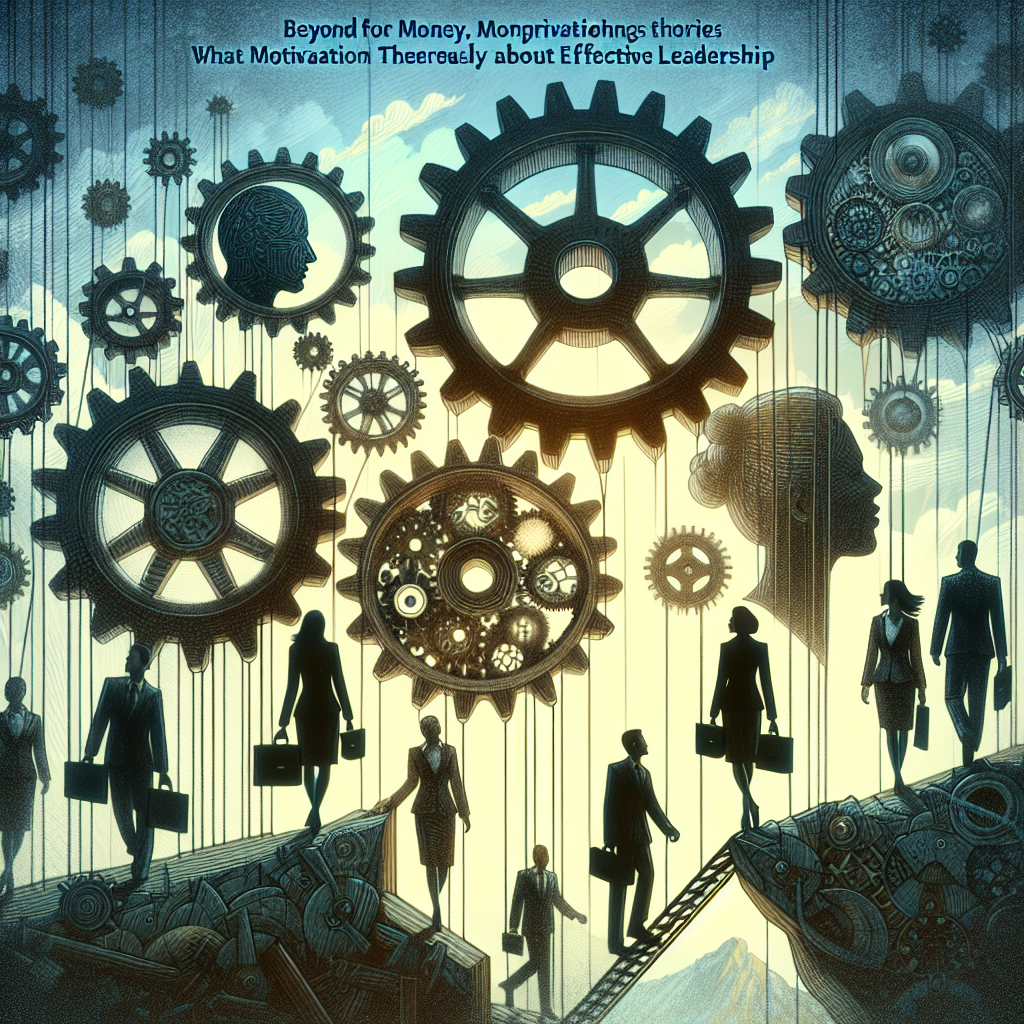
Introduction
In the ever-evolving realm of leadership, one question continues to reverberate among professionals: What truly motivates individuals to perform at their best? The traditional belief that monetary rewards serve as the ultimate motivator is increasingly being challenged by research in motivation theories. Beyond money: What motivation theories reveal about effective leadership offers a fresh perspective that emphasizes intrinsic motivation, personal growth, and team dynamics. This article will delve into the depths of these theories, showcasing how they can be applied to cultivate effective leadership in various contexts.
The Shift in Leadership Paradigms
In recent years, businesses and organizations have begun to recognize that financial incentives alone cannot drive sustained performance. Morale, engagement, and a sense of purpose are crucial to fostering an environment where individuals can thrive. Theory after theory points to a common truth: effective leadership goes beyond monetary motivations.
Understanding Motivation Theories
Before we dive into the implications of these theories on leadership, it’s essential to explore some foundational motivation models.
Maslow’s Hierarchy of Needs
Abraham Maslow’s hierarchy is one of the most well-known motivation theories. It proposes that human needs are arranged in a hierarchy from physiological needs at the base to self-actualization at the top. This theory serves as a vital framework for understanding what drives individuals.
Table 1: Maslow’s Hierarchy of Needs
| Level | Description |
|---|---|
| 1. Physiological Needs | Basic survival needs (food, water) |
| 2. Safety Needs | Security and stability |
| 3. Love/Belonging Needs | Social connections and acceptance |
| 4. Esteem Needs | Recognition, self-esteem, and respect |
| 5. Self-Actualization | Realizing personal potential |
Application: Leaders who understand where their team members stand in this hierarchy can tailor their motivational strategies accordingly. For example, a team member struggling with basic needs may not respond to recognition until these needs are addressed.
Herzberg’s Two-Factor Theory
Frederick Herzberg’s Two-Factor Theory divides workplace factors into hygiene factors and motivators. Hygiene factors (such as salary, company policies, and working conditions) do not motivate employees but can lead to dissatisfaction if lacking. Motivators (like achievement and recognition) inspire employees to excel.
Case Study: A tech startup found that by improving its office environment (a hygiene factor), employee satisfaction increased. However, the real breakthrough came when they initiated peer recognition programs, resulting in enhanced motivation and productivity—demonstrating the essence of beyond money: what motivation theories reveal about effective leadership.
Self-Determination Theory (SDT)
SDT emphasizes intrinsic motivation driven by autonomy, competence, and relatedness. It highlights the importance of nurturing environments that promote these three elements.
Relevance: Leaders should focus on creating an atmosphere where employees feel empowered to make choices, thus enhancing their sense of competence and connectedness within the team.
Vroom’s Expectancy Theory
Victor Vroom’s Expectancy Theory posits that motivation is a product of individuals’ expectations about their ability to perform tasks and the outcomes of those performances. Leaders can harness this by setting clear expectations and offering achievable challenges that link performance to desired outcomes.
The Role of Leadership in Fostering Motivation
Building Trust and Authenticity
A great leader embodies authenticity and vulnerability, nurturing trust within teams. Trust is fundamental for fostering a culture of motivation—when employees feel safe, they are more likely to express their ideas and take initiative.
Case Study: A prominent organization saw a significant boost in team engagement after its CEO shared personal challenges and values in an all-hands meeting. This act of vulnerability transformed the leadership dynamic and led to higher performance, illustrating how beyond money: what motivation theories reveal about effective leadership encompasses emotional intelligence.
Encouraging Team Autonomy
Promoting autonomy within teams not only enhances individual motivation but also sparks innovation. Leaders who delegate responsibility allow team members to take ownership, resulting in higher engagement levels.
Example: A creative agency implemented a "20% time" policy, allowing employees to work on passion projects. The outcome: increased employee satisfaction and several innovative ideas that the company subsequently adopted.
Effective Communication
Open lines of communication are essential for fostering motivation. Leaders should invite feedback and encourage dialogue to ensure employees feel valued and heard.
Tool: Regular one-on-one meetings provide opportunities for leaders to connect with their team members on a personal level, discussing not only work but also aspirations and challenges.
Case Studies: Insights from Successful Leaders
Google: Innovating with Autonomy
Google’s unique workplace culture exemplifies effective leadership that thrives on intrinsic motivation. Known for its employee-centric policies, Google’s “20% time” initiative allows employees to explore personal projects.
Analysis: This autonomy drives innovation and creativity, proving that financial incentives do not always equate to heightened performance. Instead, beyond money: what motivation theories reveal about effective leadership shines through in environments that empower individuals to pursue their passions.
Zappos: Culture of Happiness
Zappos is renowned for its commitment to employee happiness. The company invests in understanding employees’ needs beyond monetary compensation, focusing instead on creating a strong culture that values individuality.
Insight: Leaders who prioritize a positive culture can foster higher levels of employee engagement, showing that happiness may be one of the strongest motivators.
Netflix: Freedom and Responsibility
Netflix operates under a unique model emphasizing freedom and responsibility. They trust employees to manage their time effectively without micromanagement.
Implication: This model shows that allowing flexibility in the workplace can significantly enhance motivation and productivity. Leaders can take a page from Netflix by trusting their teams to make decisions, thereby driving intrinsic motivation.
Conclusion
As we reflect on the insights gathered from various motivation theories, it becomes clear that effective leadership transcends monetary incentives. By prioritizing trust, communication, autonomy, and a sense of purpose, leaders can cultivate an environment that motivates individuals to not only achieve but exceed their potential.
The journey into beyond money: what motivation theories reveal about effective leadership has illuminated the pathways through which leaders can inspire their teams to achieve greatness. As you step into your role as a leader, remember that the most effective motivators go beyond mere financial rewards, and lean into what truly inspires and energizes human potential.
FAQs
1. What is the main takeaway of motivation theories in leadership?
The central theme is that effective leadership requires understanding and nurturing intrinsic motivations rather than relying solely on financial incentives.
2. How can I assess my team’s motivations?
Engage your team in open discussions about their goals and what drives them. Regular feedback sessions can provide crucial insights.
3. What role does company culture play in motivation?
A strong company culture fosters trust, belonging, and satisfaction, which are essential for grooming motivated and engaged employees.
4. Can you give an example of a leader implementing these theories?
Certainly! Leaders at Zappos create happiness-oriented workplaces that motivate employees beyond monetary rewards by fostering a supportive culture.
5. How do I balance between financial rewards and intrinsic motivators in my leadership style?
Strive to create a culture of appreciation, recognition, and personal development while ensuring fair compensation. This blend can keep employees motivated and engaged.
By understanding and applying these principles, leaders can pave their own path toward effective leadership that transcends monetary motivations and ignites a passion for growth and achievement within their teams.


















